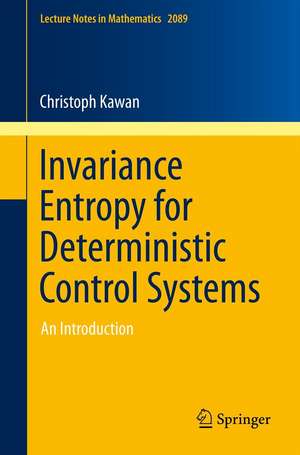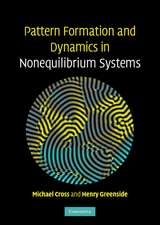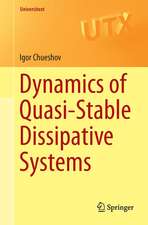Invariance Entropy for Deterministic Control Systems: An Introduction: Lecture Notes in Mathematics, cartea 2089
Autor Christoph Kawanen Limba Engleză Paperback – 14 oct 2013
Din seria Lecture Notes in Mathematics
- 17%
 Preț: 360.42 lei
Preț: 360.42 lei -
 Preț: 459.92 lei
Preț: 459.92 lei -
 Preț: 121.41 lei
Preț: 121.41 lei -
 Preț: 175.68 lei
Preț: 175.68 lei -
 Preț: 197.00 lei
Preț: 197.00 lei -
 Preț: 279.76 lei
Preț: 279.76 lei -
 Preț: 477.65 lei
Preț: 477.65 lei - 17%
 Preț: 361.88 lei
Preț: 361.88 lei -
 Preț: 252.37 lei
Preț: 252.37 lei -
 Preț: 353.99 lei
Preț: 353.99 lei -
 Preț: 138.88 lei
Preț: 138.88 lei -
 Preț: 152.61 lei
Preț: 152.61 lei -
 Preț: 116.67 lei
Preț: 116.67 lei -
 Preț: 102.77 lei
Preț: 102.77 lei - 17%
 Preț: 365.52 lei
Preț: 365.52 lei -
 Preț: 396.75 lei
Preț: 396.75 lei - 17%
 Preț: 362.12 lei
Preț: 362.12 lei -
 Preț: 396.11 lei
Preț: 396.11 lei -
 Preț: 357.78 lei
Preț: 357.78 lei - 17%
 Preț: 362.31 lei
Preț: 362.31 lei -
 Preț: 403.80 lei
Preț: 403.80 lei - 17%
 Preț: 361.70 lei
Preț: 361.70 lei -
 Preț: 499.87 lei
Preț: 499.87 lei -
 Preț: 457.03 lei
Preț: 457.03 lei -
 Preț: 395.90 lei
Preț: 395.90 lei -
 Preț: 459.00 lei
Preț: 459.00 lei -
 Preț: 487.57 lei
Preț: 487.57 lei -
 Preț: 424.01 lei
Preț: 424.01 lei -
 Preț: 487.57 lei
Preț: 487.57 lei -
 Preț: 330.55 lei
Preț: 330.55 lei -
 Preț: 325.75 lei
Preț: 325.75 lei -
 Preț: 350.30 lei
Preț: 350.30 lei -
 Preț: 331.31 lei
Preț: 331.31 lei -
 Preț: 408.37 lei
Preț: 408.37 lei -
 Preț: 328.25 lei
Preț: 328.25 lei -
 Preț: 421.28 lei
Preț: 421.28 lei -
 Preț: 276.08 lei
Preț: 276.08 lei -
 Preț: 424.60 lei
Preț: 424.60 lei -
 Preț: 422.05 lei
Preț: 422.05 lei -
 Preț: 505.01 lei
Preț: 505.01 lei -
 Preț: 422.05 lei
Preț: 422.05 lei -
 Preț: 274.93 lei
Preț: 274.93 lei -
 Preț: 335.16 lei
Preț: 335.16 lei -
 Preț: 422.27 lei
Preț: 422.27 lei -
 Preț: 497.49 lei
Preț: 497.49 lei -
 Preț: 272.81 lei
Preț: 272.81 lei -
 Preț: 428.04 lei
Preț: 428.04 lei -
 Preț: 376.22 lei
Preț: 376.22 lei -
 Preț: 427.10 lei
Preț: 427.10 lei -
 Preț: 325.92 lei
Preț: 325.92 lei
Preț: 388.13 lei
Nou
Puncte Express: 582
Preț estimativ în valută:
74.27€ • 77.39$ • 61.49£
74.27€ • 77.39$ • 61.49£
Carte tipărită la comandă
Livrare economică 03-17 aprilie
Preluare comenzi: 021 569.72.76
Specificații
ISBN-13: 9783319012872
ISBN-10: 3319012878
Pagini: 296
Ilustrații: XXII, 270 p. 2 illus., 1 illus. in color.
Dimensiuni: 155 x 235 x 16 mm
Greutate: 0.42 kg
Ediția:2013
Editura: Springer International Publishing
Colecția Springer
Seria Lecture Notes in Mathematics
Locul publicării:Cham, Switzerland
ISBN-10: 3319012878
Pagini: 296
Ilustrații: XXII, 270 p. 2 illus., 1 illus. in color.
Dimensiuni: 155 x 235 x 16 mm
Greutate: 0.42 kg
Ediția:2013
Editura: Springer International Publishing
Colecția Springer
Seria Lecture Notes in Mathematics
Locul publicării:Cham, Switzerland
Public țintă
ResearchCuprins
Basic Properties of Control Systems.- Introduction to Invariance Entropy.- Linear and Bilinear Systems.- General Estimates.- Controllability, Lyapunov Exponents, and Upper Bounds.- Escape Rates and Lower Bounds.- Examples.- Notation.- Bibliography.- Index.
Recenzii
From the book reviews:
“The topics are well organized, the exposition is clear and there are examples to illustrate the theoretical results. This book is highly recommended for both researchers and graduate students in dynamical systems, control theory and related areas. This book is particularly useful because it collects in one place a large number of seminal results that are essential for an understanding of invariance entropy.” (Alexandre José Santana, Mathematical Reviews, August, 2014)
“The topics are well organized, the exposition is clear and there are examples to illustrate the theoretical results. This book is highly recommended for both researchers and graduate students in dynamical systems, control theory and related areas. This book is particularly useful because it collects in one place a large number of seminal results that are essential for an understanding of invariance entropy.” (Alexandre José Santana, Mathematical Reviews, August, 2014)
Textul de pe ultima copertă
This monograph provides an introduction to the concept of invariance entropy, the central motivation of which lies in the need to deal with communication constraints in networked control systems. For the simplest possible network topology, consisting of one controller and one dynamical system connected by a digital channel, invariance entropy provides a measure for the smallest data rate above which it is possible to render a given subset of the state space invariant by means of a symbolic coder-controller pair. This concept is essentially equivalent to the notion of topological feedback entropy introduced by Nair, Evans, Mareels and Moran (Topological feedback entropy and nonlinear stabilization. IEEE Trans. Automat. Control 49 (2004), 1585–1597). The book presents the foundations of a theory which aims at finding expressions for invariance entropy in terms of dynamical quantities such as Lyapunov exponents. While both discrete-time and continuous-time systems are treated, the emphasis lies on systems given by differential equations.
Caracteristici
The first book to present results on the relatively new notions of feedback and invariance entropy Provides detailed proofs of all key results, together with a comprehensive exposition of the mathematical background material used therein Will be particularly interesting for readers with a background in dynamical systems theory The basic knowledge of control theory needed for its understanding is presented at great length in the first chapter Includes supplementary material: sn.pub/extras











